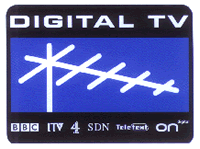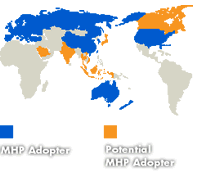 Natalie Mouyal of DigiTAG follows up on her previous piece on Wednesday that reviewed the current position of MHP services in Europe.
Natalie Mouyal of DigiTAG follows up on her previous piece on Wednesday that reviewed the current position of MHP services in Europe.
As MHP-based interactive services are launched throughout Europe, will they encourage the uptake of digital television services? Country case-studies demonstrate that the strategy adopted for the launch of interactive services does impact the roll-out in the market. Two different types of launch strategies can be used for the free-to-air DTT platform.
In a first strategy, national governments focus on the roll-out of digital terrestrial services using simple (zapper) set-top boxes that converts the digital signal for reception on an analogue television set. This strategy encourages the uptake of DTT services by promoting the purchase of a relatively inexpensive zapper set-top box in order for viewers to access an increase in the number of television programme services. Once the DTT services are accepted by the general population, broadcasters can launch interactive services in a second step. However, this strategy results in a large quantity of zapper boxes in viewer households that will need to be converted in order to access interactive services.
In a second strategy, interactive services are an integral part of the initial launch of DTT services and viewers are educated to understand that television can provide a wide range of new services. DTT is no longer a simple translation of a previously existing television services but rather a new television experience. However, this strategy requires a greater financial investment given the higher cost of an MHP-enabled set-top box when compared with zapper set-top box.
 Generally, countries have tended mix the two strategies. Viewers have benefited from both an increase in the number of television service programmes available, as well as interactive television services. Yet, this combination has not always allowed for an impressive take-off of MHP based interactive services. In the case of Finland, consumers could choose between a zapper set-top box that allows them to access more television service programmes or an MHP-enabled set-top box that allows them to access both the increased number of television services programmes as well as the interactive services. However, MHP-enabled set-top boxes make up only 5% of all set-top boxes currently purchased.
Generally, countries have tended mix the two strategies. Viewers have benefited from both an increase in the number of television service programmes available, as well as interactive television services. Yet, this combination has not always allowed for an impressive take-off of MHP based interactive services. In the case of Finland, consumers could choose between a zapper set-top box that allows them to access more television service programmes or an MHP-enabled set-top box that allows them to access both the increased number of television services programmes as well as the interactive services. However, MHP-enabled set-top boxes make up only 5% of all set-top boxes currently purchased.
So as to encourage viewers to buy MHP-enabled set-top boxes, the Italian government has provided households with a subsidy towards the purchase of their interactive set-top boxes. While this subsidy can be used for any open platform interactive boxes, such as those used to receive TV via fibre optic broadband services, it has encouraged the purchase of MHP-enabled set-top boxes. It is estimated that 1.5 million MHP-enabled set-top boxes have already been purchased since February 2004. In addition, the decrease in subsidy from €150 (~US$190 ~£102) in 2004 to €70 (~US$95 ~£51) in 2005 reflects the drop in price for MHP-enabled set-top boxes following their massive uptake.
The consumption of MHP-enabled set-top boxes has kick started the economies of scale for their manufacture. The marginal cost difference for an MHP-enabled set-top box and a zapper set-top box is now much reduced. By adopting this strategy, the Italian government has successfully prevented its market from being flooded with simple zapper set-top boxes.
 It has been assumed that many consumers will invariably prefer the cheaper zapper set-top box to a more expensive MHP-enabled set-top box. However, this reasoning disregards the type of interactive services offered. For example, should viewers find interactive services compelling and easy to use, they may be willing to spend the extra money necessary for an interactive set-top box. Thus, it would seem that consumer education is key to the successful roll-out of interactive services.
It has been assumed that many consumers will invariably prefer the cheaper zapper set-top box to a more expensive MHP-enabled set-top box. However, this reasoning disregards the type of interactive services offered. For example, should viewers find interactive services compelling and easy to use, they may be willing to spend the extra money necessary for an interactive set-top box. Thus, it would seem that consumer education is key to the successful roll-out of interactive services.
Much will depend on the role and importance attributed to interactive services. Should governments wish to promote t-government services, it is necessary to encourage households to purchase an interactive set-top box. Broadcasters may use interactive services as a means to increase their revenue and as a result invest funds in the development of appealing content. The priorities of content developers, broadcasters and governments will impact the successful roll-out of interactive services and likely lead to variations between markets.
Natalie Mouyal, works for Digitag
 In Austria, a DTT trial with MHP-based interactive services provided 150 households in Graz with access to an interactive television service called !TV4 using the telephone connection for the return channel. Using their television remote control, viewers could retrieve information services and vote. Given the success of the trial, it is likely that MHP-based interactive services will be launched alongside DTT services.
In Austria, a DTT trial with MHP-based interactive services provided 150 households in Graz with access to an interactive television service called !TV4 using the telephone connection for the return channel. Using their television remote control, viewers could retrieve information services and vote. Given the success of the trial, it is likely that MHP-based interactive services will be launched alongside DTT services. Of course MHP is not the only interactive television service system in the market. Proprietary systems such as MediaHighway and OpenTV have been installed in a large number of set-top boxes, often for cable and satellite platforms. In the United Kingdom, the MHEG standard is widely used on the terrestrial platform. As a result of the various products and services in the market, the DVB Project has been working on the development of the Portable Content Format (PCF) to deliver a wide range of interactive television services to multiple platforms with a minimum of re-authoring. It has significant interest for operators who wish to migrate towards MHP by allowing them to manage simultaneously a mixed population of devices.
Of course MHP is not the only interactive television service system in the market. Proprietary systems such as MediaHighway and OpenTV have been installed in a large number of set-top boxes, often for cable and satellite platforms. In the United Kingdom, the MHEG standard is widely used on the terrestrial platform. As a result of the various products and services in the market, the DVB Project has been working on the development of the Portable Content Format (PCF) to deliver a wide range of interactive television services to multiple platforms with a minimum of re-authoring. It has significant interest for operators who wish to migrate towards MHP by allowing them to manage simultaneously a mixed population of devices.